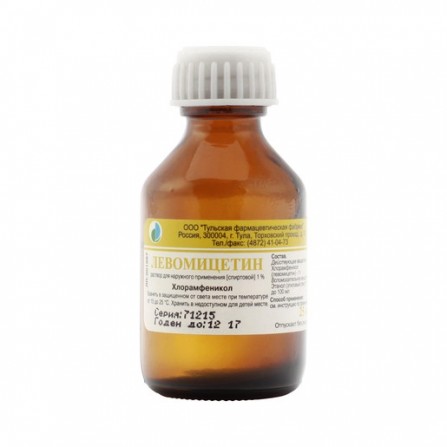Levomycetin solution alcohol 1% 25ml
Condition: New product
1000 Items
Rating:
Be the first to write a review!

More info
Active ingredients
Procaine + Chloramphenicol + Ethanol
Release form
Solution
Composition
100 ml of solution contains: Active substance: chloramphenicol 1 g.
Pharmacological effect
Broad-spectrum antibiotic. The mechanism of antimicrobial action is associated with impaired protein synthesis of microorganisms. It has a bacteriostatic effect. Active against gram-positive bacteria: Staphylococcus spp., Streptococcus spp .; Gram-negative bacteria: Neisseria gonorrhoeae, Neisseria meningitidis, Escherichia coli, Haemophilus influenzae, Salmonella spp., Shigella spp., Klebsiella spp., Serratia spp., Yersinia spp., Proteus spp., Rickettsia spp. is also active against Spirochaetaceae, some large viruses. Chloramphenicol is active against strains resistant to penicillin, streptomycin, sulfonamides. The resistance of microorganisms to chloramphenicol develops relatively slowly.
Pharmacokinetics
After ingestion quickly and completely absorbed from the gastrointestinal tract. Bioavailability is 80%. Quickly distributed in the body. Plasma protein binding is 50-60%. Metabolized in the liver. T1 / 2 is 1.5-3.5 hours. Excreted in the urine, small amounts from feces and bile.
Indications
For oral administration: infectious and inflammatory diseases caused by microorganisms sensitive to chloramphenicol, including: typhoid fever, paratyphoid fever, dysentery, brucellosis, tularemia, whooping cough, typhus and other rickettsioses; trachoma, pneumonia, meningitis, sepsis, osteomyelitis. For external use: purulent skin lesions, boils, non-healing trophic ulcers, II and III degree burns, nipple cracks in nursing women. For local use in ophthalmology: inflammatory eye diseases.
Contraindications
Blood diseases, marked abnormal liver function, deficiency of the enzyme glucose-6-phosphate dehydrogenase, skin diseases (psoriasis, eczema, fungal diseases); pregnancy, lactation, children up to 4 weeks (newborns), hypersensitivity to chloramphenicol, thiamphenicol, azidamphenicol.
Use during pregnancy and lactation
Chloramphenicol is contraindicated for use during pregnancy and lactation (breastfeeding).
Dosage and administration
Individual. When ingestion dose for adults - 500 mg 3-4 times / day. Single doses for children under the age of 3 years - 15 mg / kg, 3-8 years - 150-200 mg; over 8 years old - 200-400 mg; frequency of use - 3-4 times / day. The course of treatment is 7-10 days. When applied topically, put on gauze tampons or directly on the affected area. From above apply a usual bandage, it is possible with parchment or compress paper.Dressings are made depending on the indications in 1-3 days, sometimes in 4-5 days. They are used locally in ophthalmology as part of combined preparations in accordance with the indications.
Side effects
From the hemopoietic system: thrombocytopenia, leukopenia, agranulocytosis, aplastic anemia. On the digestive system: nausea, vomiting, diarrhea, flatulence. On the side of the central nervous system and peripheral nervous system: peripheral neuritis, optic neuritis, headache, depression, confusion, delirium, visual and auditory hallucinations. Allergic reactions: skin rash, urticaria, angioedema. Local reactions: irritant (with external or local use).


